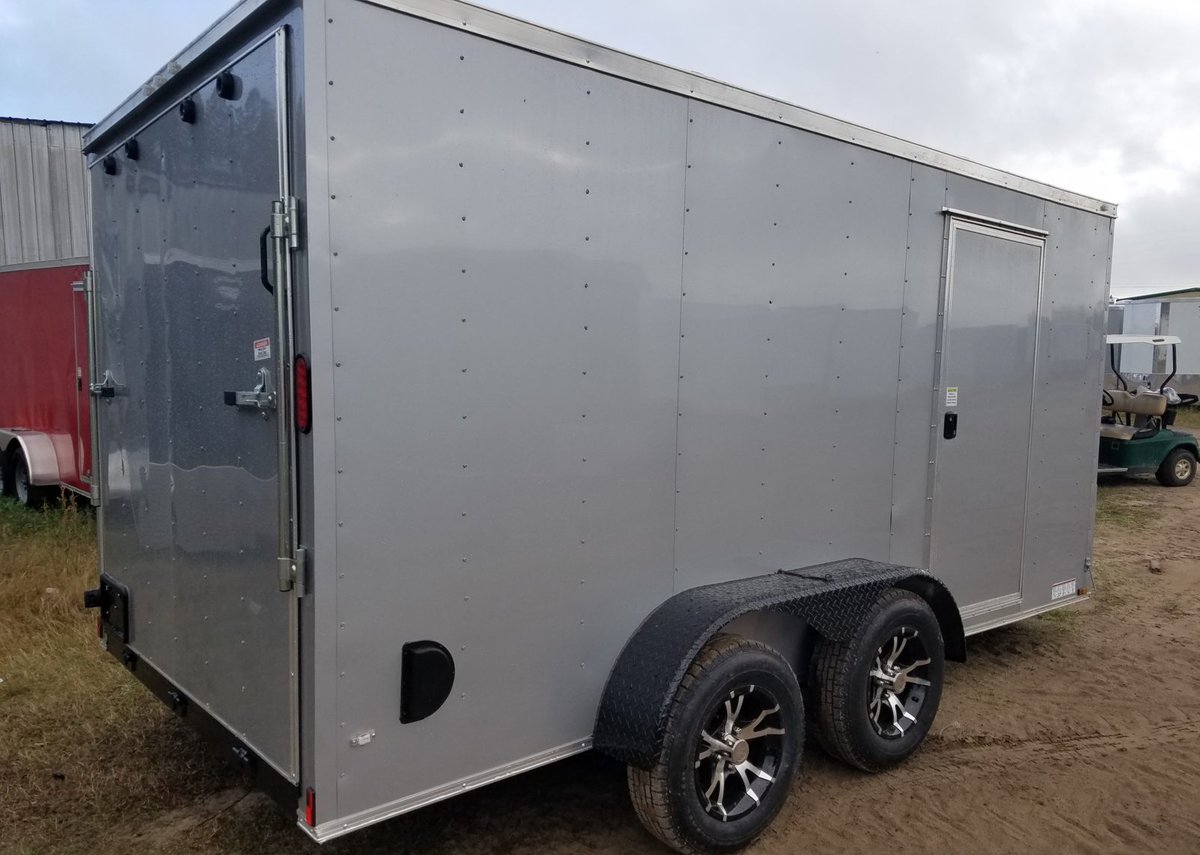How Big Is a 7'x14' Enclosed, Flat-Nose Cargo Trailer?
August 4, 2021

Cargo trailer dimensions can be a little tricky to figure out. Here are typical dimensions for a 7'x14' flat-nose cargo trailer.
Overall Exterior Dimensions of a 7'x14' Flat-Nose Cargo Trailer
| Overall Length | 17’ 10” – 18’ 0” |
|---|---|
| Overall Width | 8’ 4” – 8’ 6” |
| Overall Height | 8’ 1” – 9’ 1” |
Interior Dimensions of a 7'x14' Flat-Nose Cargo Trailer
| Interior Length | 13’ 8” – 14’ 5” |
|---|---|
| Interior Width | 6’ 6” – 6’ 7” |
| Interior Height | 6’ 2” – 6’ 11” |
Door Dimensions of a 7'x14' Flat-Nose Cargo Trailer
| Door Height | 6’ – 6’ 6” |
|---|---|
| Door Width | 6’ 5” |
Other Things to Consider
The most noticeable difference between a 7' wide trailer and an 8' wide trailer is that they both have the same overall width!
How can that be?!
It's all in the axles. Both a 7-footer and an 8-footer use a similar width axle.
However, on a 7' wide trailer, the wheels and fenders protrude past the cargo box of the trailer. On an 8' wide trailer, the wheels are effectively set into the cargo box.




Maximum Legal Road Width
In all states, the maximum legal road width for a vehicle or trailer is 8' 6". This is the same width as a typical 7' trailer due to the wheels and fenders protruding past the cargo box.
While the 8'6" width is standard on primary roads, many states mandate a maximum width of 8' on some secondary roads, as well.
How Does a 7'x14' Trailer Fit in Parking Spaces?
Typical parking spaces in the US are 8.5'-9' wide, which means that a 7' cargo trailer will occupy the full width of most parking spaces!
Most perpendicular parking spaces are usually 16-20' long. Parallel parking spaces are usually around 20-24' long.
With a maximum length of around 18 feet, this means that a 7'x14' trailer will fit in a single perpendicular or parallel parking space. Between your truck and trailer, you likely will only take up two parking places.
Rear Door Type
Should you choose a ramp or barn doors?
Some contractors that work in cities prefer to use barn doors. You can drive your trailer with the doors open to maneuver into a parking spot, and barn doors need much less sweep to open than a ramp.
Open barn doors don't add length to a trailer, but a deployed ramp will add several feet to the length that your trailer requires.
Ramps make it easy to get in and out of your trailer, and it's easy to roll heavy tools up and down the ramp - a barn door setup means that you'll need to lift tools. They are a bit quicker to open and close.
Figure out how and where you'll use your trailer and pick your doors based on those scenarios.
Outside Ladder Storage
Some contractors use the space above the fenders on the outside of the trailer to store ladders, both extension and step. This location is much faster for grabbing a ladder than taking it off the roof rack. Roof racks are high enough off the ground on a 7' wide trailer that you will need a ladder to grab a ladder or materials from the roof rack.
Storing a ladder on the roof rack or on the side of the trailer isn't a perfect method:
Your ladders will still get wet and have sun exposure, plus they'll be more prone to theft if they aren't locked up. Anything hanging on the outside of your truck or trailer will decrease your fuel efficiency, but you might find that to be a moot point when you're dragging something shaped like a refrigerator down the road.
Get work trucks and tips in your mailbox.
Your time is precious. We write about organization, tools, and techniques that make tradespeople work faster and more efficiently. Subscribe to get our articles and tips in your inbox.
We will not spam you.